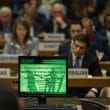We may not have the right tools to control the emerging threat
By Ralf Trapp, April 15, 2008
The potential misuse of advances in the life sciences by terrorists cannot be ignored–there is evidence both of intent and rudimentary capability. But I agree with Pal Aas that these threats can be exaggerated. Even if terrorists could manage aspects of the development, testing, and production of a novel agent, weaponization remains a challenge. Therefore, opportunistic approaches, such as the diversion of toxic or infectious materials from available sources, are far more likely.
I agree with Jonathan Tucker that we need to worry about scientists being recruited by terrorist organizations, as well as "biohackers." I also agree that they would need both explicit and tacit knowledge to transform a candidate novel agent into an effective weapon. I nevertheless feel that the threat is limited and the potential impact more local than it is sometimes portrayed. Tucker's point that the current preoccupation with "dual-use research of concern" in the life sciences is based on the belief that terrorists will eventually exploit cutting-edge advances for hostile purposes, however, is too narrow a view–what about the potential "siphoning-off" of new discoveries by states, inadvertent discoveries, or lab accidents. Plus, it does not take new life science research for terrorists to acquire a chemical or biological weapons capability–just think of the animal diseases, plant diseases, and materials and wastes that are all around us.
Additionally, neither the Biological and Toxin Weapons Convention (BWC) nor the Chemical Weapons Convention (CWC) is truly universal, and some states outside these treaties have the scientific capacity to pursue chemical or biological weapons and perceive their security to be threatened enough that they could be tempted to do so. The historical record, furthermore, shows that some States Parties to these treaties might try to exploit grey areas in the margins of their legal undertakings. This is why we need to resolve the incapacitants issue.
In regard to incapacitants, I agree with Pearson that the problem is more one of a redefinition of acceptability than of advances in science and technology. Thus, CWC States Parties may need to discuss ways to rework declarations and perhaps verification protocols. But first they need to agree where to draw a line between chemical weapons, and chemicals and delivery systems acceptable for law enforcement use. Tucker's proposal for an advisory panel on this matter is therefore important. It could draw on the recent academic debate, but it must also commit States Parties to resolve the issue in full appreciation of the long-term impact of their decision on the CWC. Pearson suggests that this process should result in criteria, standards, and methods for determining whether a toxic chemical or delivery system is consistent with law enforcement purposes. This seems to presuppose that states have discarded the "narrow" interpretation of the law enforcement clause that only riot control agents are allowed, and I am not sure that this is indeed so.
On the broader question of what to do about the growing cross-over between chemistry and biology, the "other chemical production facilities" regime would likely be involved, as both Tucker and Aas point out. This regime is the only tool in the CWC that could meet demands for transparency and control in this evolving field of science and technology.
I'm concerned, however, that the CWC was never designed to deal with the types of facilities and activities that would need to be covered. Tucker acknowledges this when he proposes a new subcategory for peptides with a declaration subthreshold high enough to exclude university and research facilities but low enough to capture commercial peptide production plants that could support a state-level biochemical weapons program. Even with a high threshold, however, it may not be easy to marshal the necessary political support from States Parties and acceptance from industry. States Parties, relevant companies, and industry associations need to explore more thoroughly what can, and what cannot, be done. The persistent lack of agreement on a verification scheme under the BWC demonstrates that there are limits to the acceptability of international verification at advanced biotech facilities. At the same time, the progress in national BWC implementation (including a closer association of security and safety issues) and the work toward codes of conduct and other self-regulatory measures in industry, research, and academia point to avenues that should be further explored by the Second CWC Review Conference.
Topics: Biosecurity
Share: [addthis tool="addthis_inline_share_toolbox"]














